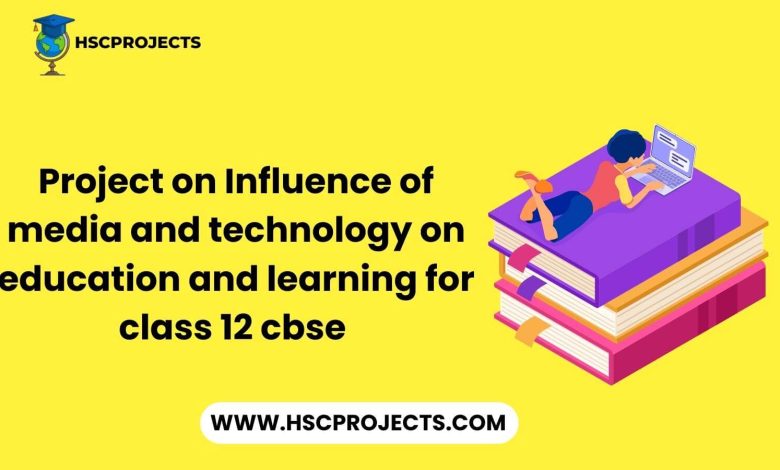
Project On Influence Of Media And Technology On Education And Learning For Class 12 CBSE
Introduction
In today’s fast-paced digital age, the profound influence of media and technology on education and learning is unmistakable. The integration of technological tools and media platforms into educational practices has ushered in a transformative era, fundamentally altering how students acquire knowledge, interact with course materials, and collaborate with peers. This project embarks on a comprehensive exploration of the multifaceted impact of media and technology on education and learning. It delves into the wide-ranging benefits, formidable challenges, and promising future prospects that this evolution presents.
In the contemporary landscape of information abundance, students have transcended reliance on traditional textbooks and classroom lectures. Instead, they navigate a vast digital realm, replete with interactive learning platforms, multimedia content, and a plethora of resources that cater to diverse learning styles and preferences. The advent of online courses, virtual classrooms, and open educational resources has expanded the horizons of education far beyond the confines of physical schools and universities.
Yet, this transformation is not without its complexities. The breakneck speed of technological progress has raised critical questions about the digital divide and equitable access to educational opportunities. Concerns regarding the credibility and reliability of online information sources have gained prominence. Moreover, the shift towards technology-driven learning prompts a reevaluation of the roles of educators, pedagogical methodologies, and the very nature of traditional classroom settings. As we embark on this exploration, we will navigate these waters, seeking to understand the intricate interplay between media, technology, and education in the modern world.
Evolution of Media and Technology in Education
Historical Overview
The journey of media and technology in education has been one of gradual transformation, fundamentally reshaping the ways in which students access information and engage in learning. Here’s a historical overview of key milestones:
- Chalkboards: The introduction of chalkboards in the 19th century replaced slates and allowed teachers to visually illustrate lessons, enhancing classroom instruction.
- Overhead Projectors: In the mid-20th century, overhead projectors became a valuable tool, enabling educators to display transparencies and share visual content more effectively.
- Television: The mid-20th century also saw the emergence of educational television programs like “Sesame Street,” which brought multimedia content into the classroom, expanding learning possibilities.
- VCRs and DVDs: The advent of video cassette recorders (VCRs) and digital versatile discs (DVDs) allowed educators to showcase educational videos and documentaries, enriching the learning experience.
- Personal Computers: The late 20th century witnessed the integration of personal computers into education, providing tools for word processing, data analysis, and early forms of computer-assisted learning.
- Interactive Whiteboards (Smartboards): Emerging in the late 20th century, interactive whiteboards empowered teachers to seamlessly incorporate multimedia content, interactive lessons, and online resources into their presentations.
- Internet Connectivity: The 1990s marked the widespread availability of the internet, revolutionizing education. It granted students access to a wealth of information, the ability to conduct research, and opportunities for online learning.
The Digital Revolution
The digital revolution, defined by the rise of the internet and personal computing, ushered in profound changes in education:
- Access to Information: The internet created a vast digital library, granting students access to a wide array of resources, including e-books and academic databases, regardless of their geographical location.
- Online Learning: The digital revolution gave birth to online learning platforms and massive open online courses (MOOCs), enabling students to pursue degrees, certifications, and courses entirely online, democratizing education.
- Personalization: Technology paved the way for personalized learning experiences, with adaptive software and learning management systems tailoring content and pacing to individual student needs.
- Global Collaboration: The internet facilitated global collaboration and cultural exchange. Students could connect with peers and experts worldwide, breaking down geographical barriers.
- Multimedia Learning: The availability of multimedia resources, such as educational videos, simulations, and interactive software, heightened engagement and comprehension in learning.
- Data-Driven Insights: Educational technology provided educators with valuable data on student performance, enabling data-driven decision-making and targeted interventions.
Benefits of Media and Technology in Education
Digital Divide
The digital divide poses a significant challenge in the realm of technology-driven education. It represents the unequal access to digital resources and technology across different socio-economic groups, which has far-reaching implications for equitable access to education.
Implications:
- Access to Learning Resources: Students lacking access to essential technology, such as computers and reliable internet, face a disadvantage. They may struggle to participate in online classes, access educational materials, and utilize digital resources, limiting their learning opportunities.
- Educational Inequality: The digital divide exacerbates educational inequality. Students from disadvantaged backgrounds may not have the same access to digital tools, hindering their ability to fully engage in the digital learning environment.
- Homework Gap: The digital divide extends to the “homework gap,” where students without internet access at home cannot complete online assignments and homework, placing them at an academic disadvantage.
- Future Disparities: Unequal access to technology during education can result in future disparities in employment opportunities, as digital skills are increasingly vital in the workforce.
Addressing the digital divide requires concerted efforts to provide affordable and reliable internet access, as well as access to digital devices, to all students. This ensures that education remains inclusive and equitable.
Screen Time and Health
The increasing use of technology for learning has raised concerns about the potential impact of excessive screen time on the physical and mental health of students.
Impact:
- Physical Health: Prolonged screen time can contribute to physical health issues, including eye strain, posture problems, and sedentary behavior. A lack of physical activity can lead to obesity and related health problems.

- Mental Health: Excessive screen time may contribute to mental health issues such as anxiety, depression, and social isolation. Constant use of digital devices can disrupt sleep patterns and affect overall well-being.

- Digital Addiction: Some students may develop digital addiction, where they struggle to control their screen time and prioritize other activities, including studying and social interactions.

To address these concerns, it is essential for educators, parents, and students to promote a healthy balance between screen time and other activities. This includes encouraging regular breaks, physical activity, and responsible use of technology.
Privacy and Security
Privacy and security are paramount concerns in the digital learning environment, particularly concerning the safeguarding of student data.
Importance:
- Data Protection: Student data, encompassing personal information and academic records, must be safeguarded against unauthorized access and data breaches.
- Privacy Concerns: Students have a right to privacy, and educational institutions and technology providers must ensure that their data is not misused or shared without consent.
- Cybersecurity: Ensuring the cybersecurity of educational platforms is vital to guard against threats like data breaches, hacking, and malware.
- Ethical Use: Ethical considerations should guide the collection and utilization of student data, with transparency regarding data practices and sharing.
Challenges and Concerns
- Regular Breaks: Encourage students to take regular breaks from screens to rest their eyes and engage in physical activity. Set a timer or schedule breaks during online learning sessions.
- Physical Activity: Emphasize the importance of physical activity and outdoor play to counterbalance extended screen time. Encourage students to engage in sports, exercise, or outdoor hobbies.
- Mindful Use: Teach students about mindful and responsible screen use. Encourage them to be aware of their screen time and prioritize activities that contribute to their well-being.
- Sleep Hygiene: Promote good sleep hygiene by encouraging students to establish a consistent sleep schedule and reduce screen time before bedtime to improve sleep quality.
- Parental Involvement: Engage parents in monitoring and guiding their children’s screen time. Provide resources and guidelines for parents to help them support healthy screen habits at home.
- Educational Content: Ensure that the screen time allocated for educational purposes is engaging and aligned with learning objectives to maximize its effectiveness.
Media Literacy and Critical Thinking
Media Literacy Skills
- Source Evaluation: Media literacy guides students in discerning the credibility and reliability of information sources. In an era rife with fake news and misinformation, this skill is paramount for making informed decisions.
- Critical Thinking: Media literacy fosters critical thinking by prompting students to question the motives, biases, and perspectives underlying media messages. It transforms them into discerning consumers of information, not passive recipients.
- Digital Citizenship: Comprehending media literacy is intertwined with responsible digital citizenship. Students learn to engage respectfully in online discussions, steer clear of cyberbullying, and safeguard their privacy.
- Media Production: Media literacy encompasses the ability to create and share media content responsibly. This skill gains significance as students immerse themselves in digital storytelling, blogging, and social media.
- Empowerment: Media literacy empowers students to actively participate in a democratic society. They can differentiate between trustworthy news sources and misinformation, contributing to an informed citizenry.
Teaching media literacy equips students with the tools needed to navigate the digital realm critically and responsibly.
Critical Thinking Development
Harnessing technology effectively can nurture critical thinking skills among students:
- Interactive Learning Platforms: Technology enables the creation of interactive learning platforms and digital simulations that challenge students to solve problems, make decisions, and think critically within a controlled environment.
- Online Discussions: Online discussion boards and forums provide arenas for students to engage in thoughtful debates, analyze diverse viewpoints, and present evidence to support their arguments.
- Digital Research: Technology facilitates efficient research, granting access to a plethora of information sources and teaching students how to critically evaluate source credibility and relevance.
- Gamification: Integrating gamification elements into educational apps and platforms can motivate students to think critically and strategize to achieve goals or solve puzzles.
- Collaborative Projects: Technology allows for virtual collaboration, where students work together, fostering critical thinking and problem-solving skills as they navigate challenges as a team.
- Online Debates and Polls: Engaging in online debates and participating in online polls or surveys encourage students to scrutinize arguments, evaluate evidence, and form their own opinions.
- E-Learning Platforms: Adaptive e-learning platforms utilize data and algorithms to tailor content to individual students, challenging them at their own skill levels and promoting critical thinking.
Future Trends and Possibilities
Blended Learning
Blended learning, an educational approach that seamlessly blends traditional face-to-face classroom instruction with online resources and digital tools, brings forth numerous advantages:
- Personalized Learning: Within the realm of blended learning, educators possess the ability to fine-tune instruction to match each student’s unique needs. Online materials can be accessed at an individual pace, while teachers offer valuable guidance and support.
- Flexibility: This approach introduces flexibility in terms of scheduling and location. Students gain the capability to access online content from virtually anywhere, forging a dynamic combination of in-person and remote learning.
- Rich Multimedia: Blended learning incorporates an array of multimedia resources, including videos, simulations, and interactive modules, heightening engagement and bolstering comprehension.
- Data-Driven Insights: Technology in blended learning captures data on student progress, enabling educators to pinpoint areas of strength and weakness and adapt their instruction accordingly.
- Preparation for the Digital Age: Blended learning equips students with vital digital literacy skills, an indispensable component of modern education and the workforce.
Artificial Intelligence (AI)
The realm of Artificial Intelligence (AI) holds immense potential in shaping the future of education:
- Personalized Learning: AI, with its data analysis prowess, delves into individual student data and learning patterns to construct bespoke learning pathways. This ensures that students receive content and exercises tailored precisely to their abilities and requirements.
- Automated Assessment: AI streamlines grading and assessment, saving educators precious time and furnishing students with immediate feedback.
- Tutoring and Assistance: AI-powered chatbots and virtual tutors step in to provide instant assistance to students, addressing queries and offering guidance beyond traditional class hours.
- Early Intervention: AI has the remarkable capability to identify students who may be encountering difficulties early on, allowing educators to intervene and supply additional support promptly.
- Content Creation: AI lends a hand in generating educational content, ranging from textbooks to practice exercises. This not only reduces costs but also broadens access to high-quality materials.
AI holds the potential to render education more efficient, effective, and accessible by harnessing data analysis and automation to elevate the learning experience.
Virtual Reality (VR) and Augmented Reality (AR)
Virtual Reality (VR) and Augmented Reality (AR) bring forth immersive learning experiences:
- VR: VR immerses students in entirely captivating environments, enabling exploration of historical sites, conducting virtual science experiments, or participating in simulated medical procedures.
- AR: AR overlays digital information onto the physical world, making it an ideal choice for interactive textbooks, historical reconstructions, or enhancing real-world experiences.
- Engagement: VR and AR breathe life into learning, rendering it more engaging and interactive, thus heightening retention and comprehension, especially for intricate subjects.
- Simulation: These technologies provide secure environments for honing skills, whether it’s surgical procedures or flight training, all without exposing learners to real-world risks.
- Global Collaboration: VR and AR facilitate virtual global classrooms, where students from across the globe can collaborate on projects or immerse themselves in diverse cultural contexts.
Case Studies and Examples
Successful Implementation
Example 1: Khan Academy Khan Academy, a nonprofit educational powerhouse, stands as a prime illustration of successful integration of media and technology in education. By leveraging an extensive library of video lessons, interactive exercises, and personalized learning dashboards, Khan Academy has bestowed the gift of free, top-tier education upon millions of learners worldwide. Through adaptive learning technology, students steer their own learning journeys, bridging knowledge gaps and embarking on a comprehensive educational voyage. The impact of Khan Academy extends beyond individual learners, with teachers embracing these resources to elevate traditional instruction.
Example 2: Summit Public Schools In the United States, Summit Public Schools has orchestrated a symphony of blended learning to usher in personalized education. They’ve employed the Summit Learning platform, a technological marvel that empowers students to set goals, monitor progress, and tap into a treasure trove of digital resources. Armed with real-time student performance data, educators fine-tune their instruction to each student’s unique needs. Summit Learning has proudly waved the flag of success, evident in improved student achievement and readiness for the realms of college and career.
Innovative Tools and Platforms
Example 1: Google Classroom Enter Google Classroom, the transformative platform that has redefined online interactions between teachers and students. A centralized haven for assignments, communication, and collaboration, it allows educators to craft virtual classrooms, dispense digital assignments, and offer immediate feedback. Students, in turn, access resources, submit work, and engage in discussions, crafting a digital learning realm that seamlessly bridges the physical and virtual worlds.
Example 2: Duolingo Duolingo, the language learning sensation, has harnessed gamification to revolutionize the art of acquiring new languages. With bite-sized lessons, Duolingo capitalizes on technology to adapt to individual learners’ strengths and weaknesses. Its universal appeal lies in its accessibility, making language acquisition an enjoyable journey for individuals across the globe.
Example 3: Coursera Coursera, the eminent purveyor of Massive Open Online Courses (MOOCs), partners with prestigious universities and institutions to offer an extensive array of online courses. Through Coursera’s platform, learners partake in video lectures, quizzes, peer assessments, and vibrant discussion forums. Access to top-tier education from global institutions is democratized, erasing barriers to knowledge acquisition.
These exemplary instances underscore the transformative potential of media and technology in education, fostering accessibility, engagement, and personalization for learners of all backgrounds and ages. They serve as luminous beacons illuminating the path toward an enriched educational experience and the broadening of access to exceptional learning opportunities.
Conclusion
In conclusion, the influence of media and technology on education and learning is undeniably profound, and its ongoing impact continues to shape the educational landscape in remarkable ways. As we’ve explored in this discussion, the integration of technology has ushered in a multitude of benefits, ranging from enhanced learning experiences and increased accessibility to the introduction of innovative tools and platforms that empower both students and educators.
However, it is crucial to recognize and confront the challenges that accompany this digital revolution. The digital divide stands as a formidable barrier to achieving equitable access to education, and concerns related to privacy and security require vigilant monitoring and action. Striking a delicate balance between harnessing the potential of technology and addressing these challenges is paramount to ensure that the advantages of media and technology persistently contribute positively to education.
Moving forward, the responsibility falls upon educational institutions, policymakers, educators, and learners to collaborate effectively. Together, they must leverage the power of media and technology while implementing safeguards and initiatives that foster inclusivity, digital literacy, and responsible usage. Through careful planning, deliberate implementation, and an unwavering commitment to adapt to evolving trends, media and technology will continue to play a pivotal role in shaping the educational journey of future generations, promoting lifelong learning, and equipping students to confront the challenges of an ever-evolving world.
Certificate
[Your Name] [Your Address] [City, State, ZIP Code] [Email Address] [Phone Number] [Date] [Name of the Institution or Organization] [Address of the Institution or Organization] [City, State, ZIP Code]Certificate of Achievement
I, [Your Name], am profoundly honored and delighted to accept this Certificate of Achievement presented to me by [Name of the Institution or Organization]. This certificate symbolizes my dedication, relentless effort, and successful accomplishment in the field of [Name of the Achievement or Program] during the academic year [Year].
This achievement is a testament to the unwavering support, guidance, and encouragement I have received from my educators, mentors, and peers throughout my educational journey. It signifies the culmination of countless hours of hard work, late nights of study, and a commitment to excellence.
I extend my heartfelt gratitude to my family and friends for their unwavering support, patience, and belief in my abilities.
This certificate serves as a reminder of the knowledge gained, challenges conquered, and the foundation laid for future accomplishments. It inspires me to continue my pursuit of learning and personal growth with renewed vigor.
I humbly accept this Certificate of Achievement with immense pride and gratitude, acknowledging the role it plays in my academic and personal development.
Sincerely,
[Your Name]In order to download the PDF, You must follow on Youtube. Once done, Click on Submit
Follow On YoutubeSubscribed? Click on Confirm
Download Project On Influence Of Media And Technology On Education And Learning For Class 12 CBSE PDF






